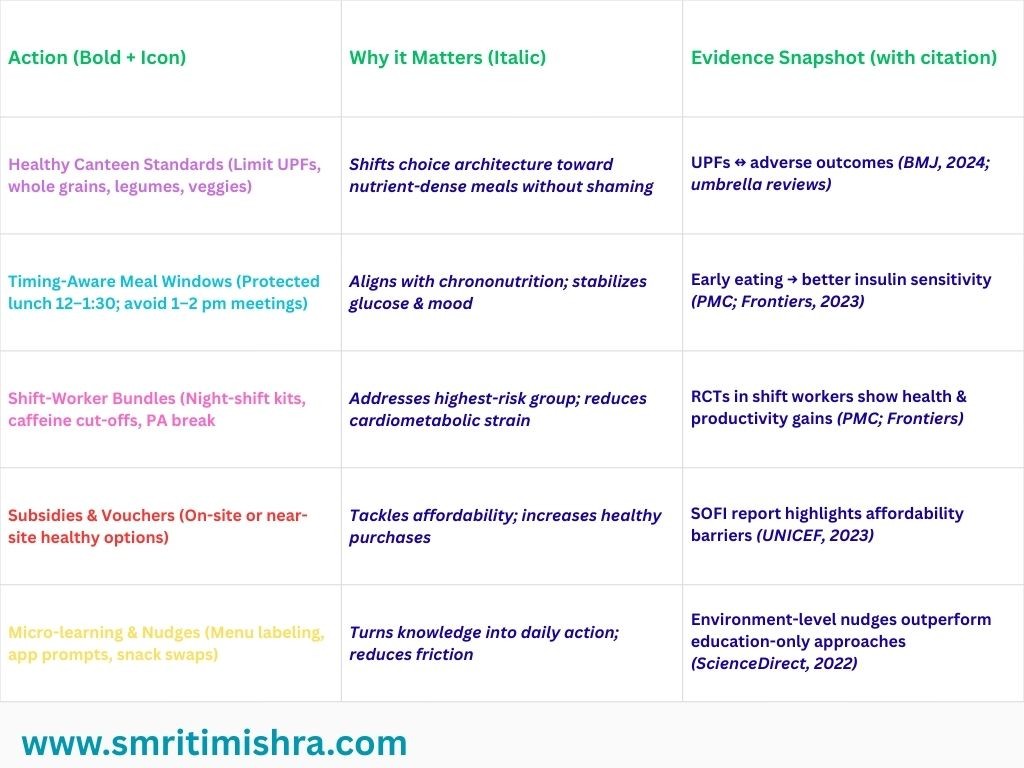What we eat has never been just a personal choice—it’s increasingly shaped by global food systems, shifting workplace cultures, and the daily pressures of modern work. In 2025, rising food prices, the surge of ultra-processed meals, and irregular eating patterns are no longer just public health debates; they’re boardroom concerns. Employees across industries are caught between affordability gaps, delivery app nudges, and meeting schedules that push meals late into the day. The result? A workforce that is fueled by caffeine and convenience, but starved of nutrients and productivity. Nutrition Week offers the perfect moment to confront this reality: are our workplaces silently becoming part of the global food crisis—or can they lead the way in reshaping it?
The Big Picture: Food Systems Under Strain
- Healthy diets are increasingly unaffordable for billions, driven by food price inflation and supply shocks—undercutting diet quality worldwide. The 2024 State of Food Security and Nutrition in the World (SOFI) estimates 2.33 billion people faced moderate or severe food insecurity, with affordability deteriorating in many regions. UNICEF DATAWorld Health OrganizationReliefWeb
- Ultra-processed foods (UPFs) now contribute the majority of calories in many countries and are linked with higher risks of cardiometabolic disease, mental health disorders and all-cause mortality—with no evidence of health benefit across outcomes in recent umbrella reviews (2024). PubMed+1ScienceDirect
- New experimental data show diet quality matters beyond calories: when diets were matched for calories and macros, an ultra-processed pattern still increased body fat and disrupted reproductive hormones in young men (Cell Metabolism, 2025). The Washington Post
Why Employers Should Care
Nearly 60% of the world’s workforce spends a third of their waking hours at work; the workplace is a high-leverage venue to address malnutrition in all its forms (undernutrition, micronutrient deficiency, and diet-related NCDs). Reviews show workplace nutrition programs improve health outcomes, though more LMIC evidence is needed to quantify business returns. PMC
Nutrition ↔ Productivity Mechanisms
- Glycemic stability & cognition: Lower-UPF, fiber-rich meals blunt post-meal glucose swings, supporting attention, mood and error reduction. (Synthesized across UPF and chrononutrition evidence.) PubMedScienceDirect
- Chrononutrition: Meal timing influences insulin sensitivity and energy balance; earlier, regular meals align better with circadian biology and may improve metabolic risk and daytime performance. PMCFrontiersSAGE Journals
- Shift work: Targeted programs for shift workers (timed meals, healthier night-shift options, combined PA + nutrition) improve health indicators; recent trials show feasibility and benefits in sedentary SMEs, too. PMCFrontiers
What’s Trending (and Concerning) in 2025
- UPF-heavy canteens & delivery defaults: App nudges and price promos skew toward fried and sugary options—quietly driving excess calories at work. (Public health nutrition analyses of food-delivery environments.) Frontiers
- Irregular meal timing in knowledge work: Lunch pushed past 2 pm, long caffeine-only mornings, and late dinners are increasingly common—and metabolically suboptimal. PMCFrontiers
- Affordability gaps: Employees in lower wage bands struggle to access healthy food near worksites as prices rise, worsening diet quality and energy levels. UNICEF DATA

Policy & Leadership Signals
- Global monitoring bodies (FAO/WHO/UNICEF) are calling for financing mechanisms that make healthy diets affordable and push back on UPF dominance. Employers can align vendor contracts and benefits with these aims. UNICEF DATAWorld Health Organization
- Wellness → Well-being, by design: The frontier isn’t more webinars; it’s changing the food environment employees actually encounter—canteens, vending, delivery partnerships, and meeting culture. ScienceDirect
A Practical 90-Day Playbook
- Audit the food environment: UPF share, sugar-sweetened beverages, portion sizes, price differentials.
- Rewrite the defaults: Healthy entrée as default, SSB upsell removed, water/unsweetened beverages front-of-house.
- Protect lunch time: Company-wide “no-meeting lunch hour” + encourage earlier eating windows for day shifts.
- Shift-friendly nutrition: Provide night-shift kits (protein + fiber + fruit), cap late-night caffeine, offer microwaves/ovens for reheating home-cooked meals.
- Measure & iterate: Track uptake, waste, engagement, and simple outcomes (post-lunch slump surveys, snack sales mix) quarterly.
Bottom Line
The global food crisis isn’t only about scarcity; it’s about the quality, timing, and affordability of what people can access—including at work. Organizations that redesign their food environments around lower UPF exposure, earlier regular meals, and affordable healthy options will see payoffs in energy, focus, and resilience—well beyond Nutrition Week. PubMedPMCUNICEF DATA
Key References
- SOFI 2024 (FAO/WHO/UNICEF/WFP/IFAD): Global hunger, affordability of healthy diets. UNICEF DATAWorld Health Organization
- UPF & Health (2023–2024 umbrella reviews; BMJ 2024): Strong associations with cardiometabolic, mental health and mortality outcomes. BMJPubMed+1ScienceDirect
- Chrononutrition (2024–2025): Earlier meals ↔ improved insulin sensitivity and energy balance; timing matters for performance. PMCFrontiersSAGE Journals
- Workplace nutrition business case (2025 review): Health gains clear; more LMIC ROI data needed. PMC
- Experimental UPF trial (Cell Metabolism, 2025): UPF diet increased fat mass and disrupted hormones despite equal calories.

